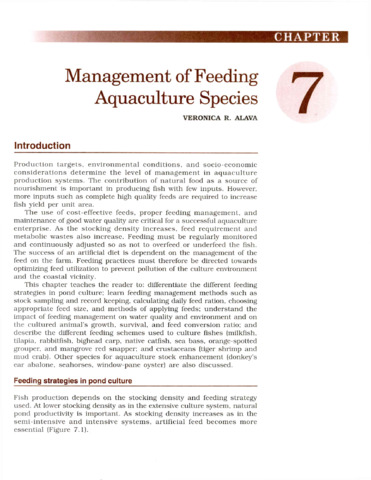Feed ration for different sizes of wild and hatchery-bred milkfish (Chanos chanos Forsskal)
- Global styles
- MLA
- Vancouver
- Elsevier - Harvard
- APA
- Help

View/
Date
1999Author
Page views
2,751AGROVOC keyword
Taxonomic term
Metadata
Show full item record
Share
Abstract
Intensified production of fish involves stocking at high densities and the use of artificial feeds. These practices result in eutrophication and environmental degradation mainly because of feed wastage and fish excreta. To minimize waste, the maximum amount of feed consumed by fish must be known. Food consumption and utilization, however, may vary with the size and physical condition of the fish. Milkfish Chanos chanos Forsskal and some hatchery-produced fish, such as seabass Dicentrarchus labrax L. have been observed to have morphological defects that could affect normal food intake and utilization. Jaw abnormalities in hatchery-bred milkfish interfere with feeding and result in very slow growth. In the Philippines, milkfish fry for production in ponds and cages are caught from the wild or produced through artificial spawning. Studies have been conducted to estimate the feed ration for milkfish reared in brackish water ponds where natural food contributes significantly to the nutrition of the fish. In ponds and marine cages, where fish are largely dependent on artificial feeds, daily feed ration has to be estimated. This study determined the maximum feed ration for different sizes of wild and hatchery-bred milkfish based on assimilation of energy.
Suggested Citation
Sumagaysay, N. S. (1999). Feed ration for different sizes of wild and hatchery-bred milkfish (Chanos chanos Forsskal). Aquaculture Research , 30(10), 789-792. https://doi.org/10.1046/j.1365-2109.1999.00382.x
Type
ArticleISSN
1355-557XCollections
- Journal Articles [1258]
Related items
Showing items related by title, author, creator and subject.
-
Management of feeding aquaculture species
Alava, Veronica R. (Aquaculture Department, Southeast Asian Fisheries Development Center, 2002)This chapter teaches the reader to: differentiate the different feeding strategies in pond culture; learn feeding management methods such as stock sampling and record keeping, calculating daily feed ration, choosing ... -
Potential of feed pea (Pisum sativum) meal as a protein source in practical diets for milkfish (Chanos chanos Forsskal)
Borlongan, Ilda G.; Eusebio, Perla S.; Welsh, Tim (Elsevier, 2003)A 12-week feeding trial was conducted to evaluate the use of feed pea meal as a dietary protein source for juvenile milkfish. Six isonitrogenous (30% crude protein) and isocaloric (16.5 kJ/g) practical diets were formulated. ... -
A preliminary study on the purified test diet for young milkfish, Chanos chanos
Lee, Dong-Liang; Liao, I-Chiu (Aquaculture Department, Southeast Asian Fisheries Development Center, 1976)In studying the nutritional requirements of young milkfish experiments were conducted to develop a purified test diet. Mixtures of the purified constituents tested were: vitamin-free casein, vitamin-free gelatin, supplemented ...





